Flexible Thin Film Functionalized by Initiative Dust Removal and Anti-Fogging for Optical Device Applications
Abstract
:1. Introduction
2. Materials and Methods
2.1. Methods and Simulation
2.2. New Efficiency Evaluation Method
2.3. Design of Electronic Driving System
2.4. Film Design
2.5. Film-Driven Algorithm Design
3. Results and Discussion
4. Conclusions
Author Contributions
Funding
Institutional Review Board Statement
Informed Consent Statement
Data Availability Statement
Conflicts of Interest
References
- Marti, E.; de Miguel, M.A.; Garcia, F.; Perez, J. A Review of Sensor Technologies for Perception in Automated Driving. IEEE Intell. Transp. Syst. Mag. 2019, 11, 94–108. [Google Scholar] [CrossRef]
- Peppa, M.V.; Komar, T.; Xiao, W.; James, P.; Robson, C.; Xing, J.; Barr, S. Towards an End-to-End Framework of CCTV-Based Urban Traffic Volume Detection and Prediction. Sensors 2021, 21, 629. [Google Scholar] [CrossRef] [PubMed]
- Zhou, K.; Zhou, Y.; Jia, Z.; Ding, G.; Ma, X.Q.; Niu, W.; Yang, S.; Han, S.T.; Zhao, J.; Zhou, Y. Single-crystal metal-organic frameworks for electronic and opto-electronic devices. Cell Rep. Phys. Sci. 2023, 4, 101656. [Google Scholar] [CrossRef]
- Song, S.; Kim, J.; Kwon, S.M.; Jo, J.W.; Park, S.K.; Kim, Y.H. Recent Progress of Optoelectronic and All-Optical Neuromorphic Devices: A Comprehensive Review of Device Structures, Materials, and Applications. Adv. Intell. Syst. 2021, 3, 2000119. [Google Scholar] [CrossRef]
- Yang, H.; Wang, Y.; Tiu, Z.C.; Tan, S.J.; Yuan, L.; Zhang, H. All-Optical Modulation Technology Based on 2D Layered Materials. Micromachines 2022, 13, 92. [Google Scholar] [CrossRef] [PubMed]
- Chen, M.K.; Liu, X.; Sun, Y.; Tsai, D.P. Artificial Intelligence in Meta-optics. Chem. Rev. 2022, 122, 15356–15413. [Google Scholar] [CrossRef] [PubMed]
- Umapathi, R.; Park, B.; Sonwal, S.; Rani, G.M.; Cho, Y.; Huh, Y.S. Advances in optical-sensing strategies for the on-site detection of pesticides in agricultural foods. Trends Food Sci. Technol. 2022, 119, 69–89. [Google Scholar] [CrossRef]
- Durán, I.R.; Laroche, G. Current trends, challenges, and perspectives of anti-fogging technology: Surface and material design, fabrication strategies, and beyond. Prog. Mater. Sci. 2019, 99, 106–186. [Google Scholar] [CrossRef]
- Mutaqin, R.; Nugroho, F.; Gumilar, N. Increase dehazing process using fast guided filter on the dark channel prior. In Proceedings of the 2017 5th International Conference on Electrical, Electronics and Information Engineering (ICEEIE), Malang, Indonesia, 6–8 October 2017; pp. 77–82. [Google Scholar] [CrossRef]
- Salameh, T.; Ramahi, A.; Alamara, K.; Juaidi, A.; Abdallah, R.; Abdelkareem, M.; Amer, E.C.; Olabi, A. Effect of dust and methods of cleaning on the performance of solar PV module for different climate regions: Comprehensive review. Sci. Total Environ. 2022, 827, 154050. [Google Scholar] [CrossRef]
- Fan, S.; Wang, Y.; Cao, S.; Sun, T.; Liu, P. A novel method for analyzing the effect of dust accumulation on energy efficiency loss in photovoltaic (PV) system. Energy 2021, 234, 121112. [Google Scholar] [CrossRef]
- Pan, D.; Jiang, Z.; Gui, W.; Maldague, X.; Jiang, K. Influence of Dust on Temperature Measurement Using Infrared Thermal Imager. IEEE Sens. J. 2020, 20, 2911–2918. [Google Scholar] [CrossRef]
- Yan, S.; Zhao, S.; Ma, X.; Ming, T.; Wu, Z.; Zhao, X.; Ma, R. Thermoelectric and exergy output performance of a Fresnel-based HCPV/T at different dust densities. Renew. Energy 2020, 159, 801–811. [Google Scholar] [CrossRef]
- Lawrentschuk, N.; Fleshner, N.E.; Bolton, D.M. Laparoscopic lens fogging: A review of etiology and methods to maintain a clear visual field. J. Endourol. 2010, 24, 905–913. [Google Scholar] [CrossRef] [PubMed]
- Sharma, R.; Wyatt, C.A.; Zhang, J.; Calle, C.I.; Mardesich, N.; Mazumder, M.K. Experimental Evaluation and Analysis of Electrodynamic Screen as Dust Mitigation Technology for Future Mars Missions. IEEE Trans. Ind. Appl. 2009, 45, 591–596. [Google Scholar] [CrossRef]
- Quan, Y.Y.; Zhang, L.Z. Experimental investigation of the anti-dust effect of transparent hydrophobic coatings applied for solar cell covering glass. Sol. Energy Mater. Sol. Cells 2017, 160, 382–389. [Google Scholar] [CrossRef]
- Fan, S.; Liang, W.; Wang, G.; Zhang, Y.; Cao, S. A novel water-free cleaning robot for dust removal from distributed photovoltaic (PV) in water-scarce areas. Sol. Energy 2022, 241, 553–563. [Google Scholar] [CrossRef]
- Alghamdi, A.S.; Bahaj, A.S.; Blunden, L.S.; Wu, Y. Dust Removal from Solar PV Modules by Automated Cleaning Systems. Energies 2019, 12, 2923. [Google Scholar] [CrossRef]
- Antonelli, M.G.; Beomonte Zobel, P.; De Marcellis, A.; Palange, E. Autonomous robot for cleaning photovoltaic panels in desert zones. Mechatronics 2020, 68, 102372. [Google Scholar] [CrossRef]
- Kwon, C.G.; Jang, K.L.; Lee, C.W.; Jung, S.G.; Foster, L. Development of an Automatic Windshield Defogging System. SAE Int. J. Passeng. Cars-Mech. Syst. 2009, 2, 404–409. [Google Scholar] [CrossRef]
- Tan, J.; Tian, P.; Sun, M.; Wang, H.; Sun, N.; Chen, G.; Song, Y.; Jiang, D.; Jiang, H.; Xu, M. A transparent electrowetting-on-dielectric device driven by triboelectric nanogenerator for extremely fast anti-fogging. Nano Energy 2022, 92, 106697. [Google Scholar] [CrossRef]
- Hunter, S.; Smith, D.; Polizos, G.; Schaeffer, D.; Lee, D.; Datskos, P. Low cost anti-soiling coatings for CSP collector mirrors and heliostats. Proc. SPIE 2014, 9175, 91750J. [Google Scholar] [CrossRef]
- Luo, X.; Lu, L.; Yin, M.; Fang, X.; Chen, X.; Li, D.; Yang, L.; Li, G.; Ma, J. Antireflective and self-cleaning glass with robust moth-eye surface nanostructures for photovoltaic utilization. Mater. Res. Bull. 2019, 109, 183–189. [Google Scholar] [CrossRef]
- Tian, L.; Luo, X.; Yin, M.; Li, D.; Xue, X.; Wang, H. Enhanced CMOS image sensor by flexible 3D nanocone anti-reflection film. Sci. Bull. 2017, 62, 130–135. [Google Scholar] [CrossRef] [PubMed]
- Tavakoli, M.M.; Tsui, K.H.; Zhang, Q.; He, J.; Yao, Y.; Li, D.; Fan, Z. Highly Efficient Flexible Perovskite Solar Cells with Antireflection and Self-Cleaning Nanostructures. ACS Nano 2015, 9, 10287–10295. [Google Scholar] [CrossRef] [PubMed]
- Banerjee, S.; Dionysiou, D.D.; Pillai, S.C. Self-cleaning applications of TiO2 by photo-induced hydrophilicity and photocatalysis. Appl. Catal. B Environ. 2015, 176-177, 396–428. [Google Scholar] [CrossRef]
- Huang, Z.S.; Shen, C.; Fan, L.; Ye, X.; Shi, X.; Li, H.; Zhang, Y.; Lai, Y.; Quan, Y.Y. Experimental investigation of the anti-soiling performances of different wettability of transparent coatings: Superhydrophilic, hydrophilic, hydrophobic and superhydrophobic coatings. Sol. Energy Mater. Sol. Cells 2021, 225, 111053. [Google Scholar] [CrossRef]
- Nayshevsky, I.; Xu, Q.F.; Barahman, G.; Lyons, A.M. Fluoropolymer coatings for solar cover glass: Anti-soiling mechanisms in the presence of dew. Sol. Energy Mater. Sol. Cells 2020, 206, 110281. [Google Scholar] [CrossRef]
- Horenstein, M.N.; Mazumder, M.; Sumner, R.C. Predicting particle trajectories on an electrodynamic screen—Theory and experiment. J. Electrost. 2013, 71, 185–188. [Google Scholar] [CrossRef]
- Mazumder, M.K.; Horenstein, M.N.; Joglekar, N.R.; Sayyah, A.; Stark, J.W.; Bernard, A.A.R.; Garner, S.M.; Yellowhair, J.E.; Lin, H.Y.; Eriksen, R.S.; et al. Mitigation of Dust Impact on Solar Collectors by Water-Free Cleaning With Transparent Electrodynamic Films: Progress and Challenges. IEEE J. Photovoltaics 2017, 7, 1342–1353. [Google Scholar] [CrossRef]
- Mazumder, M.; Sharma, R.; Biris, A.; Zhang, J.; Calle, C.; Zahn, M. Self-Cleaning Transparent Dust Shields for Protecting Solar Panels and Other Devices. Part. Sci. Technol. 2007, 25, 5–20. [Google Scholar] [CrossRef]
- Qian, D.; Marshall, J.; Frolik, J. Control analysis for solar panel dust mitigation using an electric curtain. Renewable Energy 2011, 41, 134–144. [Google Scholar] [CrossRef]
- Sayyah, A.; Horenstein, M.N.; Mazumder, M.K.; Ahmadi, G. Electrostatic force distribution on an electrodynamic screen. J. Electrost. 2016, 81, 24–36. [Google Scholar] [CrossRef]
- Calle, C.; Buhler, C.; Johansen, M.; Hogue, M.; Snyder, S. Active dust control and mitigation technology for lunar and Martian exploration. Acta Astronaut. 2011, 69, 1082–1088. [Google Scholar] [CrossRef]
- Niu, H.; Luo, S.; Yao, X.; Li, T.; Ai, M.; Zhou, R.; Wang, H.; Wan, L.; Du, Y.; Hu, L.; et al. A review of transparent superhydrophobic materials and their research in the field of photovoltaic dust removal. Mater. Sci. Semicond. Process. 2023, 166, 107741. [Google Scholar] [CrossRef]
- Sharma, R.; Wyatt, C.; Zhang, J.; Mazumder, M.K.; Calle, C.I.; Mardesich, N. Performance Analysis of Electrodynamic Self-Cleaning Transparent Films for its Applications to Mars and Lunar Missions. In Proceedings of the 2007 IEEE Industry Applications Annual Meeting, New Orleans, LA, USA, 23–27 September 2007; pp. 434–437. [Google Scholar] [CrossRef]
- De, S.; Kumar, M.; Manna, S.; Ghosh, S.; Sinha, K.; Adak, D.; Maity, S.; Bhattacharyya, R. Surface engineering of solar glass covers for soiling related issues by applying electrodynamic screens (EDS). Surf. Interfaces 2021, 25, 101222. [Google Scholar] [CrossRef]
- Sara, U.; Akter, M.; Uddin, M.S. Image Quality Assessment through FSIM, SSIM, MSE and PSNR—A Comparative Study. J. Comput. Commun. 2019, 7, 8–18. [Google Scholar] [CrossRef]
- Mazumder, M.K.; Horenstein, M.; Stark, J.; Erickson, D.; Sayyah, A.; Jung, S.; Hao, F. Development of Self-Cleaning Solar Collectors for Minimizing Energy Yield Loss Caused by Dust Deposition. In Proceedings of the ASME 2013 7th International Conference on Energy Sustainability Collocated with the ASME 2013 Heat Transfer Summer Conference and the ASME 2013 11th International Conference on Fuel Cell Science, Engineering and Technology, ASME 2013 7th International Conference on Energy Sustainability, Minneapolis, MN, USA, 14–19 July 2013. [Google Scholar]
- Atten, P.; Pang, H.L.; Reboud, J.L. Study of Dust Removal by Standing-Wave Electric Curtain for Application to Solar Cells on Mars. IEEE Trans. Ind. Appl. 2005, 45, 75–86. [Google Scholar] [CrossRef]
- Jones, T.B. Electromechanics of Particles; Cambridge University Press: Cambridge, UK, 1995. [Google Scholar] [CrossRef]
- Mazumder, M.K.; Horenstein, M.; Stark, J.; Hudelson, J.N.; Sayyah, A.; Heiling, C.; Yellowhair, J. Electrodynamic removal of dust from solar mirrors and its applications in concentrated solar power (CSP) plants. In Proceedings of the 2014 IEEE Industry Application Society Annual Meeting, Vancouver, BC, Canada, 5–9 October 2014; pp. 1–7. [Google Scholar]
- Johnson, M.E.; Tadikamalla, P.R. Computer Methods for Sampling from the Gamma Distribution; Los Alamos National Lab.(LANL): Los Alamos, NM, USA, 1978. [Google Scholar]
- Guerriero, V. Power law distribution: Method of multi-scale inferential statistics. J. Mod. Math. Front. 2012, 1, 21–28. [Google Scholar]
- Calle, C.; Chen, A.; Immer, C.; Csonka, M.; Hogue, M.; Snyder, S.; Rogriquez, M.; Margiotta, D. Dust Removal Technology Demonstration for a Lunar Habitat. In Proceedings of the AIAA SPACE 2010 Conference & Exposition, Anaheim, CA, USA, 30 August–2 September 2010. [Google Scholar] [CrossRef]
- Chesnutt, J.K.; Ashkanani, H.E.; Guo, B.; Wu, C.Y. Simulation of microscale particle interactions for optimization of an electrodynamic dust shield to clean desert dust from solar panels. Sol. Energy 2017, 155, 1197–1207. [Google Scholar] [CrossRef]
- Zhao, X.; Chen, Z.; Yan, S.; Ming, T.; Wu, Z.; Ma, R. Influence of Dust Accumulation on the Solar Reflectivity of a Linear Fresnel Reflector. J. Therm. Sci. 2021, 30, 1526–1540. [Google Scholar] [CrossRef]
- Panat, S.; Varanasi, K.K. Electrostatic dust removal using adsorbed moisture–assisted charge induction for sustainable operation of solar panels. Sci. Adv. 2022, 8, eabm0078. [Google Scholar] [CrossRef]
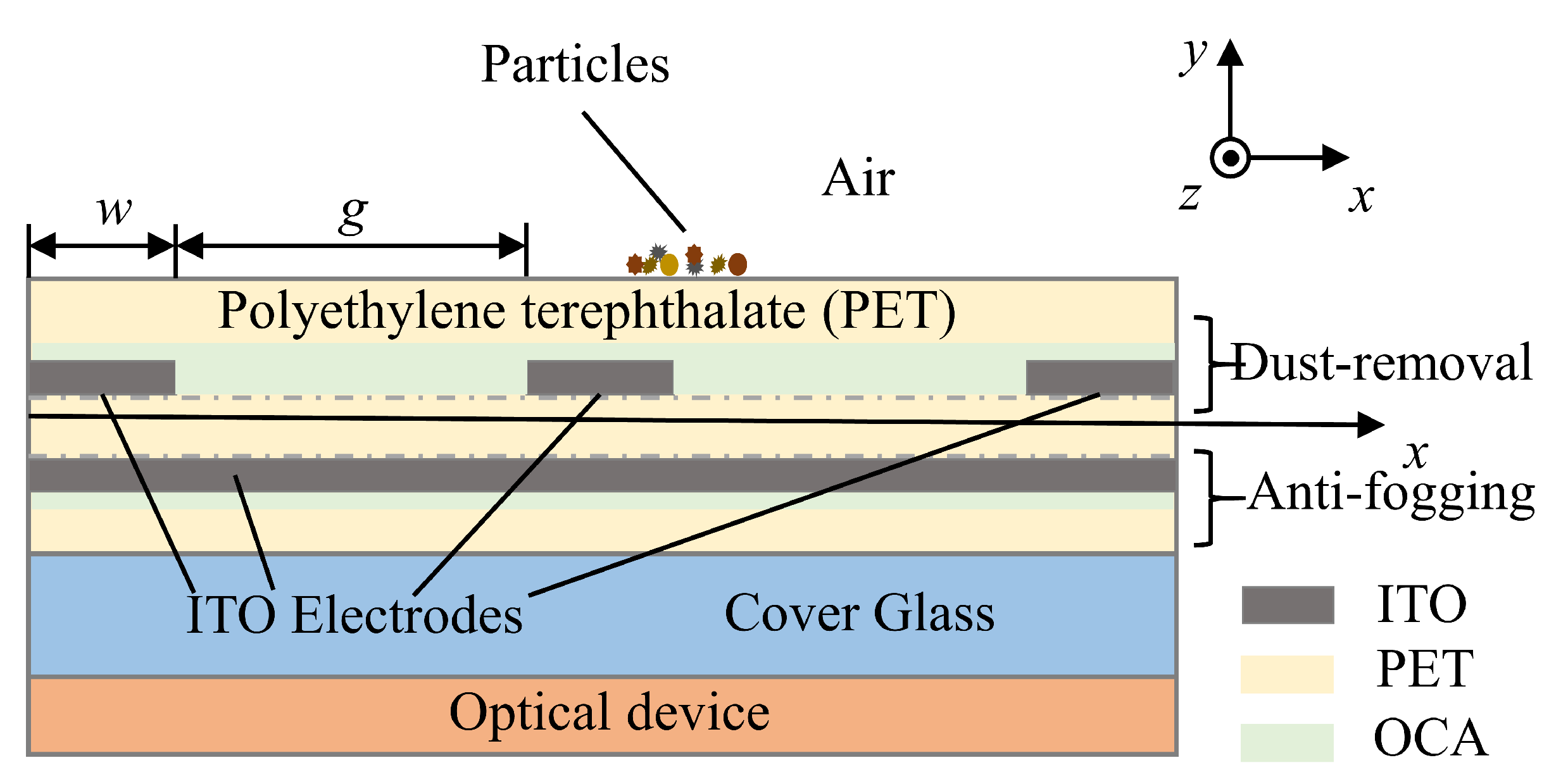
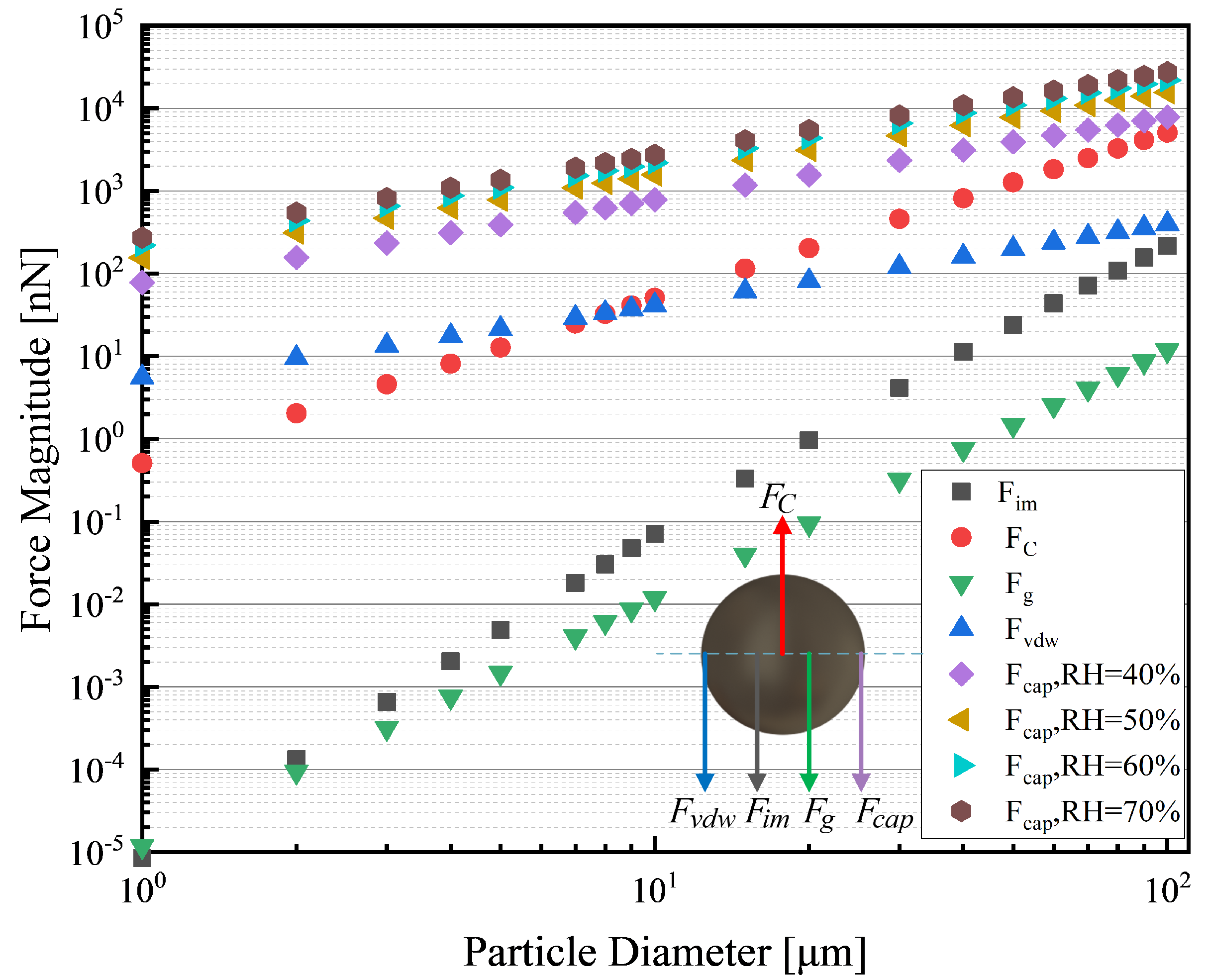


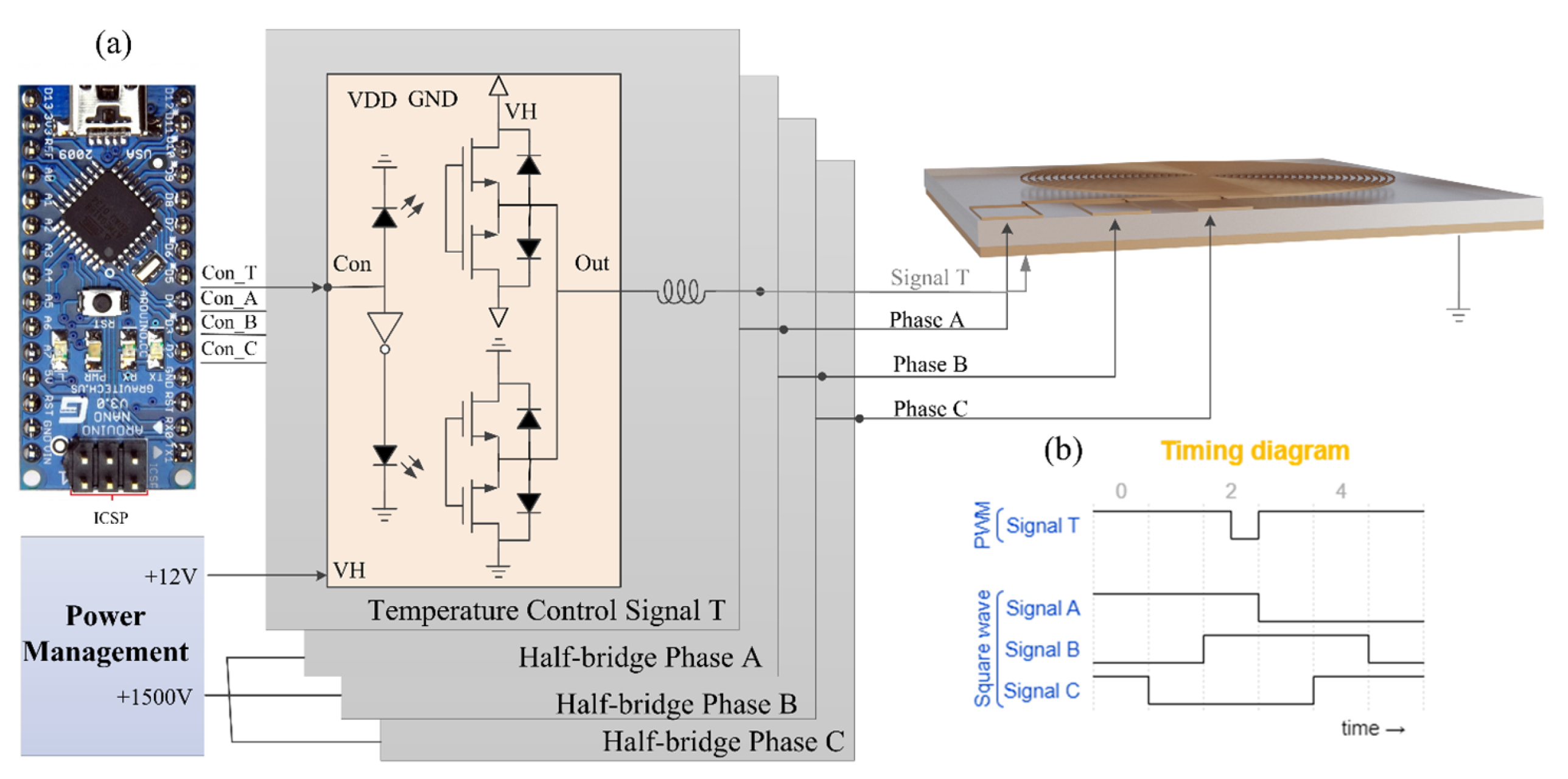
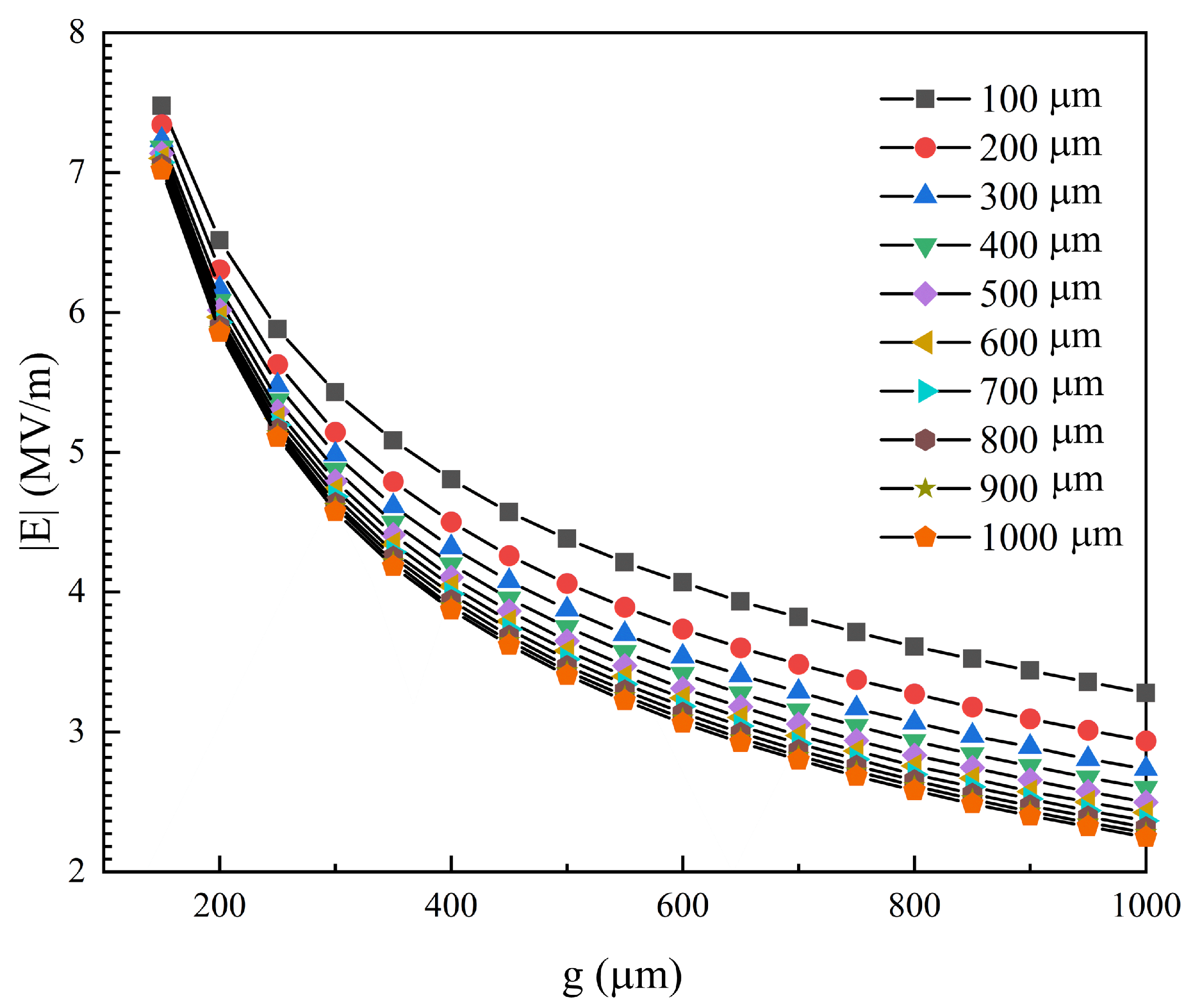
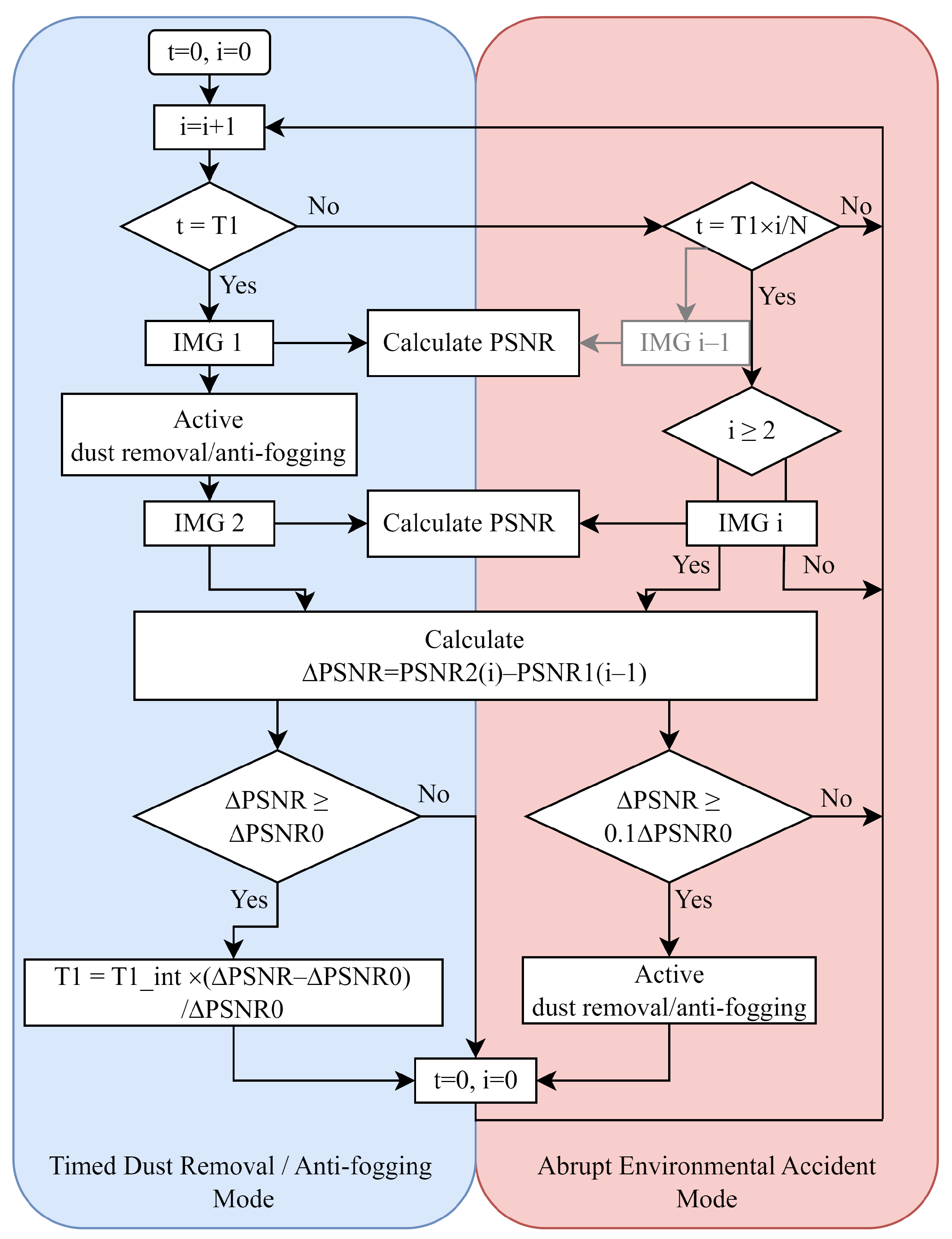
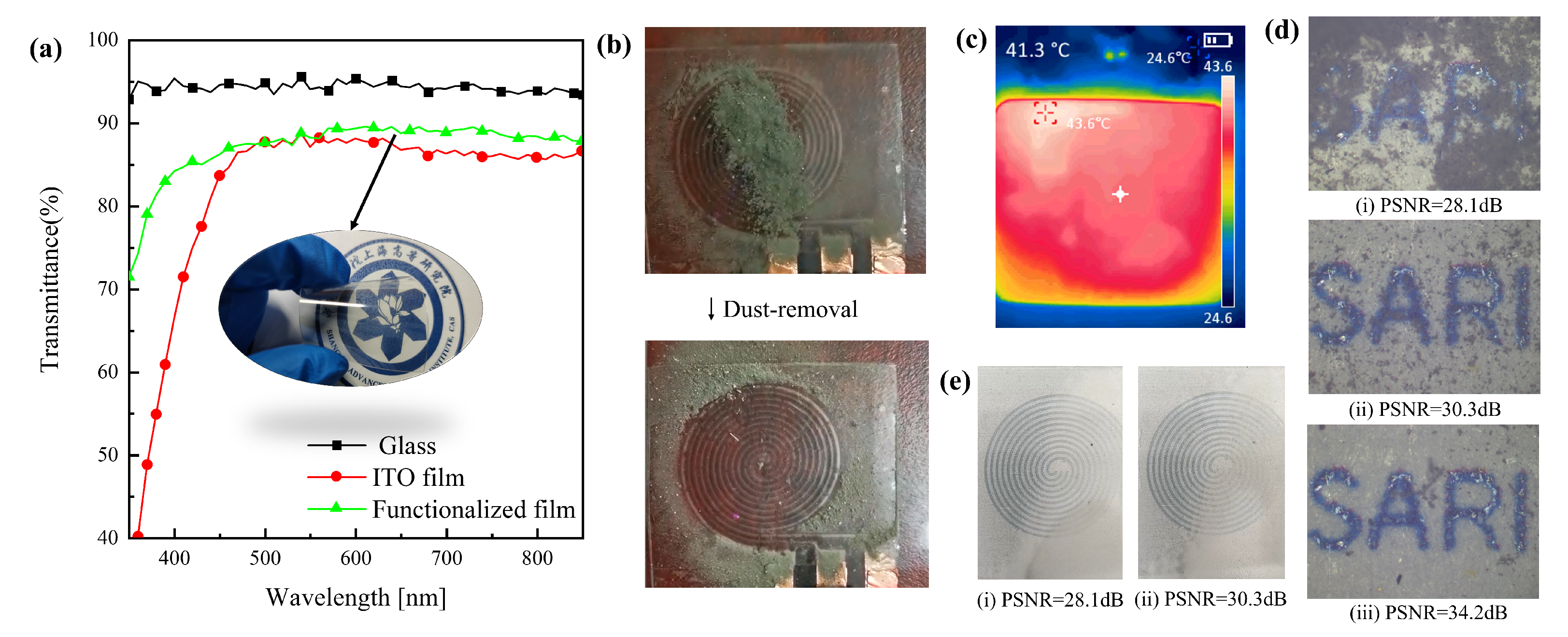
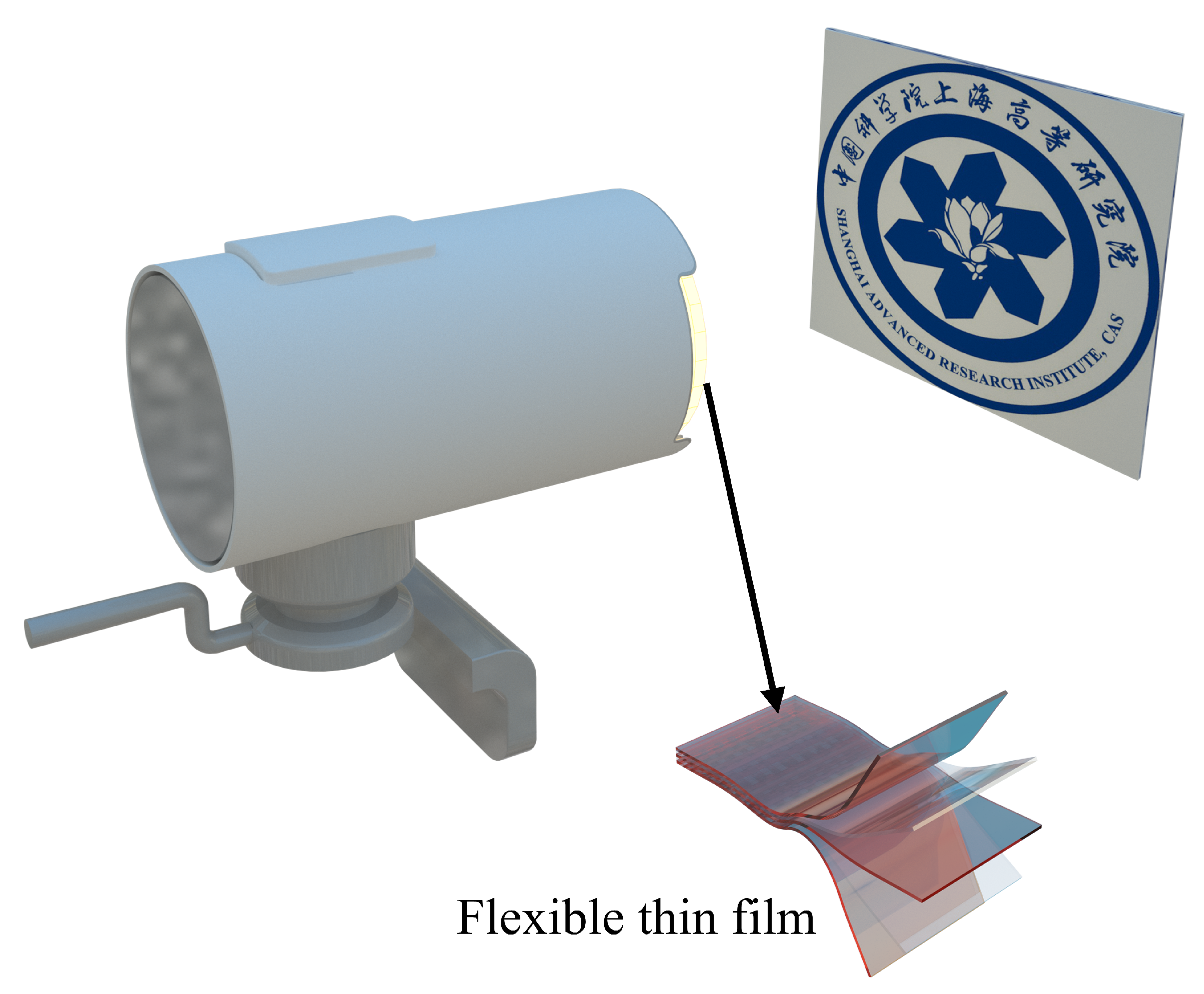
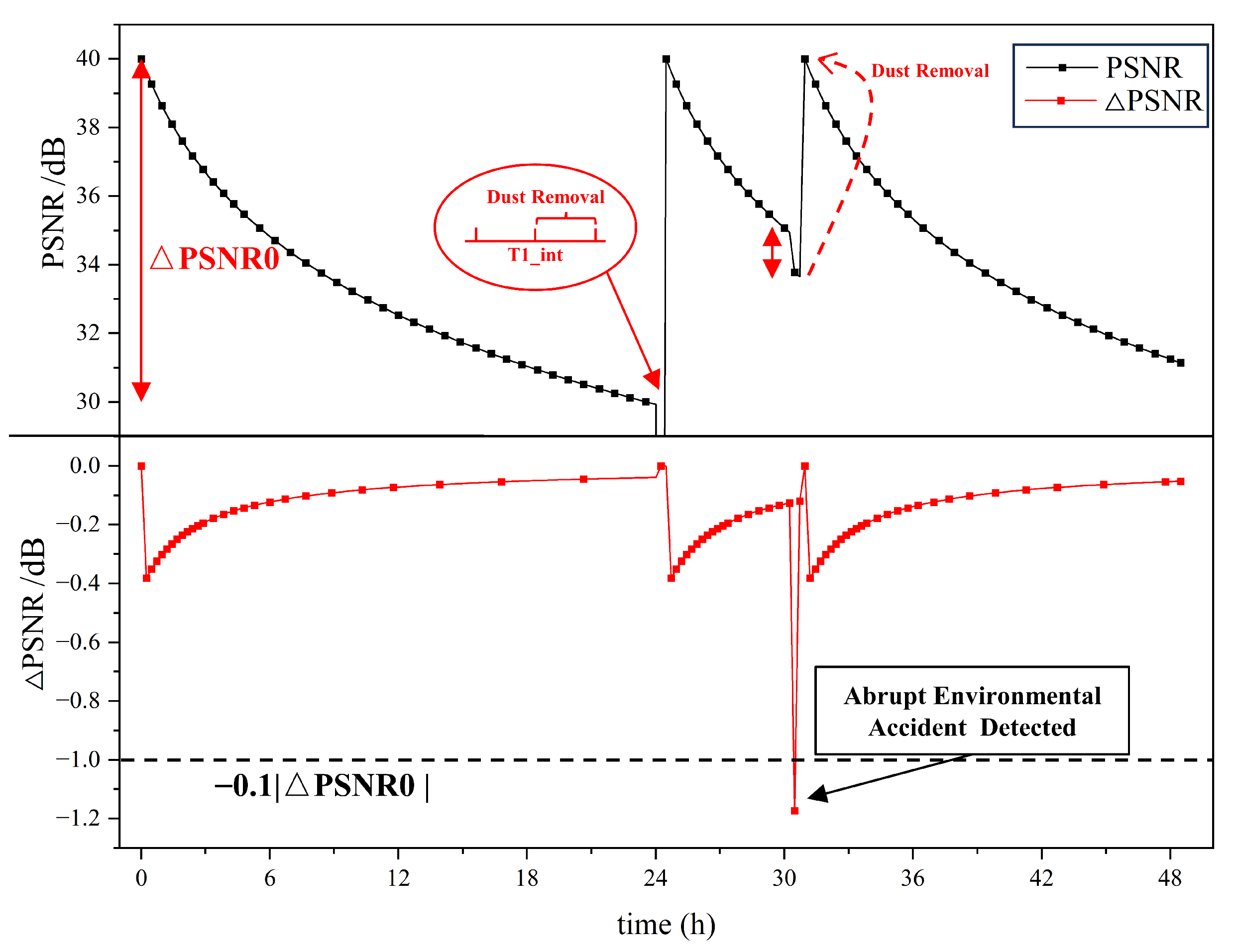
Disclaimer/Publisher’s Note: The statements, opinions and data contained in all publications are solely those of the individual author(s) and contributor(s) and not of MDPI and/or the editor(s). MDPI and/or the editor(s) disclaim responsibility for any injury to people or property resulting from any ideas, methods, instructions or products referred to in the content. |
© 2023 by the authors. Licensee MDPI, Basel, Switzerland. This article is an open access article distributed under the terms and conditions of the Creative Commons Attribution (CC BY) license (https://creativecommons.org/licenses/by/4.0/).
Share and Cite
Feng, Y.; Tian, L.; Huang, Z.; Yang, C.; Guo, L.; Jiang, Y.; Wei, C.; Guo, Y.; Wang, H. Flexible Thin Film Functionalized by Initiative Dust Removal and Anti-Fogging for Optical Device Applications. Sensors 2024, 24, 57. https://doi.org/10.3390/s24010057
Feng Y, Tian L, Huang Z, Yang C, Guo L, Jiang Y, Wei C, Guo Y, Wang H. Flexible Thin Film Functionalized by Initiative Dust Removal and Anti-Fogging for Optical Device Applications. Sensors. 2024; 24(1):57. https://doi.org/10.3390/s24010057
Chicago/Turabian StyleFeng, Yingqi, Li Tian, Zunkai Huang, Chenghe Yang, Linhai Guo, Yuwei Jiang, Chenye Wei, Yu Guo, and Hui Wang. 2024. "Flexible Thin Film Functionalized by Initiative Dust Removal and Anti-Fogging for Optical Device Applications" Sensors 24, no. 1: 57. https://doi.org/10.3390/s24010057




